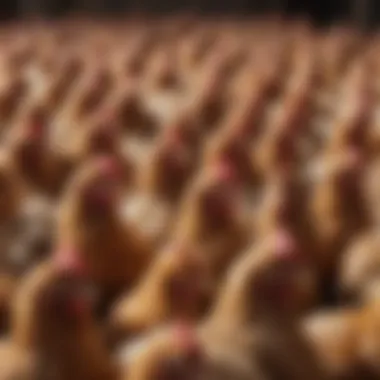How Much Food Should You Feed Your Chickens?


Intro
Understanding the nutritional needs of chickens is crucial for their health and productivity. This guide aims to clarify how much food to feed chickens by discussing various key factors such as age, breed, and the purpose for which they are raised. Proper feeding not only supports growth but also enhances egg production and overall well-being.
Animal Overview
Common Names
Chickens, or scientifically known as Gallus gallus domesticus, are domesticated birds widely kept for their eggs and meat. Common names include hen, rooster, and pullet, depending on the age and sex of the bird.
Scientific Classification
Chickens belong to the family Phasianidae. They fall within the order Galliformes. This classification helps to understand their biological family, which relates them closely to other birds like pheasants and quails.
Geographic Range
Originally, chickens were domesticated in Southeast Asia thousands of years ago. Today, they are found all around the globe, adapting to various climates and environments. This adaptability aids in their integration into diverse farming practices, whether in small backyards or large commercial operations.
Behavior and Social Structure
Social Behavior
Chickens exhibit fascinating social structures. They establish pecking orders, which dictate the hierarchy within a flock. Understanding these social interactions can influence how well chickens adapt to their environments, both in free-range settings and confined spaces.
Communication
Chickens communicate through a variety of vocalizations and body language. Each sound conveys different meanings, from alerting others about potential predators to signaling when it's time to feed. This communication plays a significant role in maintaining group dynamics and ensuring the flock's safety.
Mating and Reproduction
Mating behaviors in chickens are precise and ritualistic. The rooster's famous mating call signals his presence to the hens. Chickens usually lay eggs regularly, influenced by factors such as light exposure and age. Proper nutrition during this period is vital for egg production and the health of both the chicks and the hen.
Habitat and Ecosystem
Natural Habitat
Chickens thrive in various environments, including backyard coops, free-range farms, and large scale poultry housing. They require adequate space, ventilation, and shelter from harsh weather conditions to live healthily.
Food Sources and Diet
Chickens are omnivores, consuming a variety of foods, including grains, seeds, insects, and greens. The specific diet can influence the quantity of food provided, which will depend on the bird's age and purpose, whether for meat, eggs, or as pets.
Role in Ecosystem
Chickens play a significant role in agricultural systems. They help in pest control by consuming insects and contribute to nutrient recycling through manure. Their presence can positively affect soil quality and manage weeds when integrated into the farming process.
Proper feeding practices are essential to promote the health and productivity of chickens. Understanding their unique needs can create a thriving environment.
The End
Understanding Chicken Nutritional Needs
Understanding the nutritional requirements of chickens is a fundamental aspect of their husbandry. The health and productivity of a chicken directly correlate to its diet. Proper nutrition ensures that chickens grow healthy, produce eggs efficiently, and maintain a strong immune system.
When feeding chickens, several essential elements must be considered. These include the types of nutrients required, the age of the birds, and any specific needs related to their breed or purpose. Neglecting these factors could lead to deficiencies, suboptimal production, or even the failure of poultry farming endeavors.
Essential Nutrients for Chickens
Chickens require a balanced diet that provides essential nutrients. The main categories of nutrients include proteins, carbohydrates, fats, vitamins, and minerals.


- Proteins: Needed for growth and egg production. Birds require different protein levels depending on their development stage.
- Carbohydrates: They provide energy. Grains and cereals are common sources.
- Fats: Important for energy and helps in the absorption of certain vitamins.
- Vitamins and Minerals: Vital for various metabolic processes and overall health. For example, calcium is essential for egg shell formation.
Providing a balanced diet rich in these nutrients is crucial to ensure optimal health and productivity in chickens. A lack of any crucial nutrient can lead to severe health problems and decreased output.
Age-Specific Nutritional Requirements
The needs of chickens vary significantly at different stages of life. Young chicks, pullets, and adult hens each have unique dietary requirements.
- Chicks: Require a high-protein diet, typically around 20-24% for growth and development. Starter feeds provide this concentrated nutrition.
- Pullets: During their transition to laying hens, their nutritional needs shift. Feeding a grower ration with protein levels around 16-18% will support their development and prepare them for egg production.
- Adult Hens: Once they reach maturity, hens require a balanced layer feed enriched with calcium for eggshell production. A typical layer feed contains around 16% protein and added calcium.
By paying attention to these age-specific needs, chicken keepers can promote healthy growth, enhance egg production, and ensure the overall well-being of their flock.
Factors Influencing Food Quantity
Understanding the quantity of food required for chickens is not a one-size-fits-all approach. Several factors play a significant role in determining how much feed a chicken should receive. These elements include breed variability, the purpose of keeping chickens, and environmental conditions. Each factor brings unique considerations that can influence the specifics of feeding practices. Moreover, having insight into these variables allows chicken owners to tailor their feeding strategies effectively, ensuring maximum health and productivity in their flocks.
Chicken Breed Variability
Different chicken breeds have distinct dietary needs. For instance, laying hens often require a higher protein intake than broilers, due to their reproductive demands. Heritage breeds tend to be more efficient foragers, which means they may extract nutrients from their environment better than commercial breeds. This foraging ability can lead to variability in the supplementary feed they require. Hence, it is essential for chicken keepers to understand the specific needs and characteristics of their chosen breed.
A careful study of breed requirements can prevent underfeeding or overfeeding. When feeding laying hens, a diet formulated with a protein content of around 16-18% is advisable. Conversely, for broiler chickens, a protein level closer to 20-24% promotes healthy growth. Owners should consult breed-specific resources or body condition scores to optimize nutritional intake.
Purpose of Keeping Chickens
The intended purpose behind keeping chickens significantly affects the food requirements. Are they intended for egg production, meat production, or simply as pets? Egg-laying hens, for example, need increased nutrients to aid in egg formation, while broilers focus on rapid weight gain.
Here are some considerations based on purpose:
- Egg Production: High-energy feeds with appropriate calcium and protein levels support optimal egg yield.
- Meat Production: Need for higher protein to boost growth rates.
- Pets: Diet can focus on high-quality feed with less emphasis on protein than for production birds.
Understanding this purpose will help in tailoring feed formulations and quantities. Owners should regularly assess their flock's health and productivity to make necessary adjustments.
Environmental Conditions
Chickens are sensitive to their surroundings, and environmental factors can directly affect their food consumption. Fluctuations in temperature, humidity, and housing conditions influence feed intake. In hotter climates, chickens tend to eat less due to heat stress. Thus, it is significant to monitor ambient temperatures and make adjustments to feeding practices accordingly.
In cold weather, chickens may require more feed to maintain body heat. Therefore, adjusting feed quantity based on these environmental factors is crucial. Consider the following:
- Hot Climate: Provide feed in the cooler parts of the day and ensure plenty of fresh water.
- Cold Climate: Increase feed availability during colder months to support energy needs.
Utilizing sheltered housing can also help shield chickens from extreme environmental conditions, thereby promoting consistent feeding habits.
Key Takeaway: Understanding how breed, purpose, and environment influence food quantity is essential for healthy flock management. By recognizing these factors, chicken owners can create a balanced feeding strategy that enhances growth, productivity, and overall well-being of their birds.
Feeding Guidelines by Age
Feeding guidelines based on age is crucial for maintaining chicken health and ensuring their productivity. Chicks, pullets, and adult chickens have distinct nutritional needs that evolve as they grow. Not providing the right amount or type of food can lead to growth issues, health problems, and reduced egg production. Hence, understanding these requirements ensures that chickens develop properly and sustain their productivity throughout their lifespan.
Chicks: Feeding Requirements
Chicks require special attention immediately after hatching. They need to be fed a specifically formulated starter feed that is high in protein. This protein supports their rapid growth during the first few weeks of life. The protein content should typically be around 18-20%. Also, ensuring they have access to clean, fresh water is vital, as hydration directly impacts their growth and overall health.
Feeding chick starter for the first six weeks is advisable. After this period, gradual transition can begin to avoid digestive issues. It is important to monitor their growth closely. A healthy chick should show signs of being active and socially interactive.
For optimal feeding, consider the following guidelines:
- Provide feed at least three times a day
- Use shallow feeders to facilitate easy access and reduce waste
- Introduce grit only after the chicks are a few weeks old to aid in digestion
Pullets: Transitioning to Layer Feed
As chicks grow into pullets around the age of 6 weeks up to about 20 weeks, their nutritional needs shift significantly. During this phase, pullets prepare for laying eggs. Thus, transitioning to a layer feed with a protein content of about 16% is essential. This feed also includes added calcium to support strong eggshell formation.


Pullets should adapt to layer feed by 18 to 20 weeks to ensure they have the necessary nutrients as they begin egg production. Keeping track of their weight and overall health is crucial, as this ensures they have transitioned properly without setbacks.
Here are some key points for feeding pullets:
- Gradually mix the layer feed with the grower feed for 1-2 weeks before fully switching
- Monitor individual body weights to avoid over or underfeeding
- Ensure consistent access to fresh water
Adult Chickens: Maintenance Feeding
Adult chickens sustain their nutritional needs through maintenance feeding to keep them healthy and productive. Depending on their purpose, whether for eggs or meat, their feed requirements can vary. A general recommendation for adult layers is a balanced feed containing around 16% to 18% protein with sufficient calcium levels.
This feeding schedule can generally remain consistent throughout the year, but adjustments may be necessary based on factors such as egg production cycles and seasonal changes.
Typical feeding strategies include:
- Offering layer feed once or twice daily, preferably at the same times
- Providing access to scratch grains in moderation to encourage foraging behavior
- Regularly assess body condition to ensure they maintain optimal weight
Following these guidelines and modifying them as necessary will help ensure that adult chickens remain healthy and productive for a sustained period.
Daily Feed Intake Recommendations
Understanding how much feed to give chickens daily is essential for their health and production levels. Proper feeding ensures that chickens receive the necessary nutrients to grow, lay eggs, and maintain vitality. Different factors influence the quantity of feed needed, including age, size, and their purpose on the farm. Emphasizing tailored feeding amounts can prevent issues such as obesity, nutritional deficiencies, or developmental problems.
General Daily Feeding Guidelines
When determining the daily feed intake for chickens, a general guideline is about 0.25 to 0.5 pounds (approximately 113 to 227 grams) of feed per chicken per day. This range can vary based on specific conditions. Key factors that should be considered include:
- Age: Younger chickens, especially chicks, require less feed compared to adult layers.
- Breed: Larger breeds like the Jersey Giant may need more feed than smaller ones such as the Bantam.
- Activity Levels: Active chickens that roam freely will typically consume more than those kept in a confined space.
- Environmental Factors: Chickens in colder climates might eat more to maintain body heat.
It is beneficial to monitor the chickens’ body condition regularly. Adjustments to feed can be made based on observations. Keeping track of these variables will help maintain optimal health and productivity.
Adjustments for Free-Range Chickens
Free-range chickens often have different feeding requirements compared to those that are kept in coops. When chickens have the liberty to roam, they scratch and forage for insects, grass, seeds, and other natural foods, affecting their overall feed intake needs. Consider the following:
- Foraging Ability: Free-range chickens might consume about 10 to 20 percent less commercial feed because of the natural food sources available.
- Supplemental Feeding: Even with foraging, it is important to provide a consistent source of commercial feed to ensure that they receive balanced nutrition.
- Seasonal Adjustments: During warmer months, free-range chickens might eat less due to increased foraging. Conversely, in colder seasons, their feed intake may rise due to higher energy needs.
- Layer Feed: This should be offered to laying hens to support egg production.
- Grower Starter: This is suitable for young chickens until they reach maturity.
It's crucial to assess free-range chickens regularly. This will ensure they are getting enough nutrients for their specific needs while enjoying the benefits of their environment.
Common Feed Types and Their Benefits
In order to provide chickens with the right nutrition, it is essential to understand the various feed types available. Different feed formulations can influence growth, egg production, and overall health. Thus, choosing the appropriate feed type is crucial for both backyard flock owners and commercial chicken producers. Several factors guide the selection process, including nutritional content, cost, and availability.
Commercial Feed Formulations
Commercial feeds are widely utilized because they are designed to meet the specific nutritional needs of chickens at various life stages. These formulations generally fall into three categories: starter feed, grower feed, and layer feed.
- Starter Feed: This is meant for chicks, containing a higher protein level to aid rapid growth. During this phase, chicks require about 20-24% protein to support their developing bodies.
- Grower Feed: This type typically provides a balanced diet with slightly lower protein content, often ranging from 16-18%. This stage occurs after the chicks transition from starter feed and before they reach maturity.
- Layer Feed: For adult hens, layer feed is formulated to include essential nutrients necessary for egg production. It generally contains around 16-18% protein as well as calcium, which is vital for producing strong eggshells.
Using commercial feed can simplify nutrition management. However, one must pay attention to ingredient quality. Not all commercial feeds are created equal. Look for feeds that use high-quality grains and avoid fillers.
Natural and Organic Feed Options
Natural and organic feeds are becoming more popular among chicken keepers who value sustainability and health. These feeds often consist of ingredients that are free from synthetic pesticides, fertilizers, and antibiotics.
Some benefits of natural and organic feed options include:
- Healthier Chickens: Natural feeds can lead to better overall health by providing essential nutrients without harmful additives.
- Enhanced Flavor: Chickens that consume organic feed often produce eggs with richer flavors and higher nutritional value.
- Environmental Sustainability: Organic feed production often involves more sustainable farming practices, supporting biodiversity and reducing chemical runoff.


While these feed options can be more expensive, the long-term benefits may justify the higher cost. It is essential to verify that the organic feed meets the nutritional needs of chickens across various ages.
Ultimately, whether you choose commercial or organic feed, the goal is the same: to provide a balanced and nutritious diet that fosters healthy and productive chickens. The right choice will depend on your specific circumstances and priorities, such as budget, availability, and personal ethics surrounding animal husbandry.
Choosing the right feed type is pivotal, as it directly impacts the health and productivity of your chickens.
Feeding Practices and Schedules
Feeding practices and schedules are crucial components in managing a healthy flock of chickens. A structured feeding routine ensures that the birds receive their necessary nutrients, which promotes their physical health and productivity. By establishing consistent schedules, chicken keepers can monitor consumption patterns more effectively. This leads to easier adjustments based on the chickens' needs. Moreover, a well-planned feeding schedule minimizes waste and helps in budgeting feed costs, which can accumulate over time.
Setting a Feeding Routine
Establishing a feeding routine is vital for both young and adult chickens. Consistency in time and quantity helps chickens know when to expect their meals. This routine encourages natural foraging behaviors and reduces stress, which can improve overall well-being.
- Frequency: Generally, chickens should be fed at least twice a day. Younger birds may require more frequent feedings, while adults might thrive with two meals.
- Timing: Set a specific time for feeding each day, preferably at the same time in the morning and evening. This regularity supports their metabolic processes.
- Quantity: The amount of food should be calculated based on the total number of birds. Observe how much they eat during feeding time to adjust for next meals.
Involving diverse feeding methods, like scatter feeding or using troughs, can keep chickens engaged and reduce competition. Varying the feeding environment also promotes natural behaviors and encourages movement.
Monitoring and Adjusting Feed Quantities
Monitoring how much each chicken eats is essential to identify any changes in appetite or health issues. Weighing the feed before and after meals helps in understanding consumption rates. Frequent monitoring can reveal patterns and allow for timely adjustments.
- Signs of Overfeeding: If chickens exhibit excessive weight gain or sluggish behavior, it may indicate overfeeding. Adjust feed quantities as necessary.
- Signs of Underfeeding: Conversely, if chickens seem more aggressive or show signs of feather pecking, it may be a symptom of hunger or nutrient deficiency.
- Seasonal Adjustments: Chickens may need varying quantities of feed depending on the season. During colder months, chickens may require more calories to maintain body heat.
Regularly monitor the health and behavior of your chickens to adjust feeding schedules and promote their best growth and egg production.
Signs of Underfeeding or Overfeeding
Understanding the signs of underfeeding or overfeeding in chickens is crucial for maintaining their overall health and productivity. The right balance of feed ensures that chickens thrive, while being either overfed or underfed can lead to significant health problems. Addressing these signs can lead to better management practices and healthier birds.
Identifying Nutritional Deficiencies
A chicken's nutritional deficiencies can present themselves in various ways. Common symptoms include a lack of energy, weight loss, and decreased egg production. Birds may also exhibit feather problems, such as poor feather quality or excessive molting. Calcium and protein deficiencies are particularly important to identify; chickens requiring calcium often may have weak eggshells, while low protein levels can lead to stunted growth in younger birds.
To monitor for these deficiencies, ensure regular observation of chickens. Check their appearance and behavior closely. A change in eating habits, such as reduced food intake, can indicate an underlying deficiency. Supplementing their diet with appropriate vitamins and minerals can help address any gaps. Keeping a feeding log can also assist in tracking the impact of nutritional changes over time.
Behavioral Indicators of Overfeeding
Overfeeding can lead to obesity in chickens, affecting their mobility and overall health. Signs include lethargy and a lack of interest in typical activities like foraging. If a chicken appears excessively plump, this can indicate that it has consumed too much food relative to its energy needs.
Additionally, close monitoring of fecal output can reveal overfeeding. An increase in soft or watery droppings might suggest too much feed, especially if they consume a large amount of low-quality or grain-based feed. Regular observation of feeding behavior is vital. If chickens are always at the feeder and appear uninterested in other activities, this can be a clear signal of overfeeding. Adjusting portion sizes and introducing a more balanced diet can help mitigate these issues.
Conclusion: Properly feeding chickens is a balance. Understanding the signs of both underfeeding and overfeeding enables chicken keepers to make timely adjustments, promoting better health and productivity.
End: Optimal Feeding Strategies
In the world of poultry management, understanding optimal feeding strategies is fundamental for achieving the best health and productivity of chickens. The key to efficient feeding lies in grasping the specific needs of each chicken according to its age, breed, and purpose. With the right approach, chicken keepers can ensure that their birds receive adequate nutrition, thereby fostering not just physical well-being but also enhanced egg production and overall vitality.
Feeding chickens does not rely solely on providing food; it requires a comprehensive strategy that incorporates quality feed, dietary adjustments as chickens grow, and close observation of their individual needs. Implementing optimal feeding practices can prevent issues such as underfeeding or overfeeding, both of which can lead to health problems down the line.
"Optimal feeding strategies not only enhance chicken health but also improve egg yield and growth rates."
Recap of Key Feeding Principles
When reflecting upon the feeding principles discussed throughout this article, several core elements emerge:
- Age and Stage of Life: Chickens have different nutritional needs at each stage of life. For instance, chicks require a high protein diet, while adult chickens benefit from a balanced maintenance feed.
- Breed Considerations: Different breeds may need varied nutrient profiles. Selecting feed specific to the breed can lead to improved health outcomes.
- Purpose of Keeping Chickens: Whether for egg production, meat, or companionship, the purpose influences the dietary needs of the chickens.
- Environmental Factors: Seasonal changes and flock behavior can impact the appropriate amount of feed necessary. Adjusting quantities based on these variables is essential.
This overview highlights why a tailored feeding strategy matters for maintaining flocks in good health and achieving production goals.
Final Recommendations for Chicken Keepers
For those dedicated to keeping chickens, applying the following recommendations can help streamline feeding practices:
- Regular Monitoring: Chicken keepers should regularly assess their flock's health and activity levels. This helps in adjusting feeding amounts according to weight changes or breed-specific needs.
- Rotate Feeding Types: Incorporating a variety of feed types, both commercial and natural, can provide a balanced diet. Consider offering grains, legumes, and even kitchen scraps in moderation.
- Establish a Routine: Setting a consistent feeding schedule can help regulate the flock's feeding habits, aiding in both health and productivity.
- Educate Yourself: Keeping informed about new research and trends in poultry nutrition can lead to better feeding strategies, ultimately benefiting the flock.
By adhering to these recommendations and principles, chicken keepers will be well-equipped to create and maintain a thriving environment for their birds.







